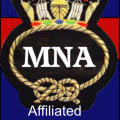Captain John Rose is Director (Maritime) of CHIRP, the Confidential Hazardous
Incident Reporting Programme.
John started his career at sea with a majoroil company, subsequently qualifying as
Extra Master Mariner and achieving a Master of Laws degree. Thereafter, his
positions ashore included Harbour Master and later an assignment as General
Manager with an oil company in Houston. Subsequently he set up his own
consultancy company. This work included
advising shipping companies on improving their safety management systems. In
his leisure time, John has a narrow boat and has recently completed a 1050 mile
trip around the canals of England and Wales. He is a Fellow of the Nautical
Institute and a Younger Brother of Trinity House.
Mal Nicholson
Despite having been flooded
out of house and home over
Christmas and now having to
live on his boat Mal Nicholson
still managed to provide me
with the following report and a
brilliant video (in three parts)
on his exploits with the
beautiful “Spider T” during her
fund-raising voyage to
promote the 2013 Seafarers
Awareness Week and raise funds for the Sailors Chidren’s Society.
Great stuff Mal and I’m sure everyone will want to join me in wishing you all the best for drying out and repairs to your home. C E
Friday
For myself the revival of this once popular event started with a 4.30am alarm call on Friday 20 September. With summer in its latter
stages it was pitch black on arrival at Keadby Lock, where owner and captain of the Humber Super Sloop ‘Spider T’ Mal Nicholson,
having already completed his pre-trip checks, was awaiting the arrival of crew and passengers. The lock keeper was ready at 6.00am
and we prepared to cast off. As the bridge swung and we headed towards the lock he called to inform us we were at level water with
the River Trent and could go straight through. For Mal and the crew final preparations for this event started on the previous
Wednesday with the releasing of the mainsail from the mast hoops, removal of the boom and gaff and lowering of the mast to
accommodate the bridges on the way up river. The first of these, Keadby Bridge, was met within minutes of leaving the lock, timed to be
under well before high tide to give good clearance, which proved to be only three feet (one metre). About 20 minutes later we reached
the M180 flyover and clearance here was about six feet (two metres). At the helm for our trip up river was Frank who had worked the
river for many years, it was obvious that he was in his element and enjoyed every minute. Also aboard was Ken Collier, Chairman of
West Stockwith Yacht Club and organiser of the event, Ken John Steggles and my wife Lesley, who would be holding a small exhibition
of paintings and prints on board. With a full moon to our starboard side, we passed East Ferry and at about 7am, as the sun rose on
our port side, you suddenly realise why you volunteer for these events, what a beautiful morning for a trip up the River Trent! Our aim
was to let the spring tide carry us to West Stockwith with minimal revs on the engine for steerage. Arriving at the top of the tide, we
hung off the jetty until the tide turned and slipped into the lock about 9.30am. Mooring up in prime location across from The Waterfront
Inn, we set about getting the mast up, the boom and gaff back in position, running rigging in place and sails hoisted. Crewmembers
Julian and Ernie joined us by road to give a help-in-hand and by mid-afternoon the sails were set. Following this, a succession of
visitors from the Yacht Club, pub and other vessels taking part in the event boarded ‘Spider T’, took a tour of her Edwardian interior and
watched a video or two of her recent exploits. In the early evening the rest of the crew made their way home. Mal’s wife Val arrived
followed by a quick wash and change before a good meal at The Waterfront Inn. By the time we had eaten it was dark and we
discussed the pros and cons of leaving the sails up overnight, finally, airing on the cautious side, Mal and myself dropped all the sails
and lashed them down, just in case a breeze got up in the night. Then it was off to the Yacht Club to sample a few of those special
brews brought in for the Beer Festival.
Saturday
Opening for public viewing was not until late morning so it was a leisurely start with a hearty cooked breakfast on board ‘Spider T’. In
the middle of hoisting the sails Mal and Val were called on to attend the official opening of the event. Starting with a meet and greet
the guests with breakfast rolls (yes, a second breakfast!) in the club house and continuing with an official opening outside the
Chesterfield Canal Trust tent with Canal & River Trust representatives followed by the official naming ceremony of a little canal tug. The
opening ceremony introduced by Ken Collier, chairman of West Stockwith Yacht Club, was shared between Danny Brennan, East
Midlands Chairman of the Canal & River Trust and Robin Stonebridge, Chairman of the Chesterfield Canal Trust, who explained their
visions for the future of the waterways. Then moving down to the waterfront where Katie Jackson of the Canal & River Trust explained
how they are introducing the waterways to school children with canal side nature trails and a boat naming competition. Year 5 and 6 of
Misterton Primary School came up with ten names and East Midlands Waterways voted for the winning name. Katie then introduced
Molly who presented the winning name ‘Blue Cuckoo’ on behalf of Misterton Primary School to the crew of the tug. With the official
proceedings completed it was back to ‘Spider T’ to hoist the mainsail and, with light winds forecast, the topsail too. This, being the first
time I had been involved with hoisting the topsail, was an interesting exercise. With the full sails set we opened up to visitors, literally
hundreds and hundreds of visitors, all day long they filed aboard some gushing with questions, others quietly looking around but all were
‘wowed’ by what they saw. Finally, at about 6pm, we were forced to put a barrier across to stop the flow and enable us to tidy up the
ship, lower the sails and hoist the string of colour-changing LED lights to show her off during the evenings events, these being the Beer
Festival at the WSYC and live bands, including The Torn, in the grounds of The Waterfront Inn.
Sunday
Another leisurely start as we weren’t open to the public until about 10.30am. A warm sunny day greeted us as we lowered the lights
and packed them away before another hearty cooked breakfast. Then we hoisted the sails once more and prepared for the visitors,
surely we would not be as busy as yesterday? Late morning we had a look around the stalls, walked along the canal side for a while
and watched the water-skiing display by Marnham Boat Club members. Then it was back to ‘Spider T’ to give conducted tours and
answer questions for the remainder of the day. The sun continued to shine and the visitors came in their droves from near and far.
Around teatime we lowered the sails, bagged the topsail, foresail and jib, removed the gaff, boom and mainsail and lowered the mast in
readiness for the return journey. In between this we had to break off several times to give a more visitors a tour of the ship. Not only did
we match Saturday’s total but increased it by half as much again! By the time the mast was down we had built up a large thirst so it was
off to the WSYC to sample some more of those special brews with a short interval to slip over to The Waterfront Inn for a steak dinner
mmmm nice.
Monday
Morning mist and heavy dew soon turned into another warm bright sunny day at West Stockwith. We completed final preparations for
the trip back down river and walked over the road for a hearty cooked breakfast at The Waterfront Inn (there seemed to be a pattern
here). With passengers and crew on board we headed for the lock at about 11am and out onto the river as the tide ebbed, the clear
blue sky had filled in with clouds but it was warm with light winds. Frank was at the helm once again and we reached Keadby Lock right
on time at 2pm. Once moored up it was back up with the mast yes we’ve been here before! Personally, what I expected to be a
rather mediocre weekend turned out to be an exceptional weekend. In spite of the work involved in getting ‘Spider T’ to this event the
warm welcome, friendly locals and many, many interested visitors really did make it rather special …bring on next year!!
Dave Everatt
Spider T crewmember
HKSPS webmaster.
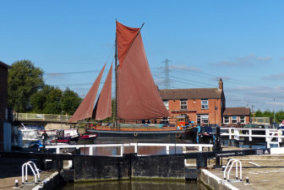
Spider T
“Isambard Brunel” - Just a bit of bumf you or other members might find useful.
Isambard Brunel is a Survey/Pilot vessel owned by the Bristol Port Company. She has
various bits of kit aboard to carry out different types of survey work. The main system is
a multi-beam unit which gives 100% seabed coverage. We cover the upper reaches of
the River Severn, working out of a home berth in the old Avonmouth dock.
She's getting on a bit now. Built up in Bristol by David Abel’s yard in 1996 she is all
steel, therefore a bit of a lump at 68 tonnes, so the twin Cummins engines only push her
along at 11.5 knots.
I have been lucky enough to be skipper/coxswain of her for nine years now, which has
flown by! We use AIS and can be tracked on Marine Traffic if you desire.
Cheers,
Martin Pick
Martin Pick
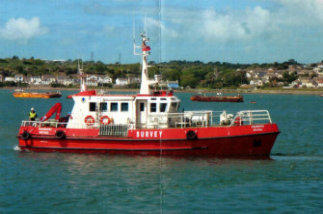
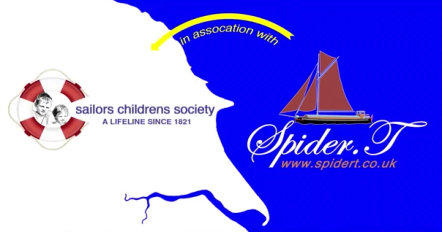
Boats, Beers & Bands
West Stockwith Rally 2013
Having seen the Island Packet Yachts at boat shows we finally took the plunge and bought
our “retirement” boat in 2006. Following a six month search we finally found an IP350 (36
foot) model in Kotka, Finland. Having done a fair bit of coastal cruising and racing, I was not
fazed at all at the thought of sailing the boat home to the UK. However, and perhaps a little
naively, I totally misjudged the time it would take to get the boat back to the UK. During
preparation for our return trip I had a panic attack when I saw the rock strewn nature of the
south coast of Finland. I ended up making the right decision to buy a chart plotter for this
stage of the journey. My nerves needed the additional assurance we got from the Chart
Plotter when passing down narrow channels with awash rocks within 10ft each side of the
boat even though these were charted channels using post markers as turning points and
leading marks. At the time we were still working and this was a holiday for us so from
Finland we took the decision to cross Sweden via the Gota Canal. This route is well
recommended and is extremely popular for all sorts of boats. The Gota is twinned with the
Crinnan Canal and serves the same purpose.
On reaching Goteborg at the western end of the Gota canal, we ran out of time, so had to
find winter berthing for our boat. In retrospect this was the best thing that could have
happened as it dawned on us over the winter how fantastic the Baltic area is for boating. In
every country around the Baltic we have been welcomed by good people in plentiful safe
harbours and with relatively cheap costs compared to the UK. Apart from the good sailing,
the biggest bonus has been the weather. Its far dryer than the UK and daytime
temperatures are steady in the summer months at around 20 degrees C with plenty of sun.
We can spend up to 6 months of the year on our boat, but the outer 3 months get very chilly
in the evening. So 3 to 4 months is normal for the growing numbers of UK boats we see in
the Baltic.
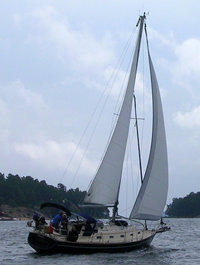
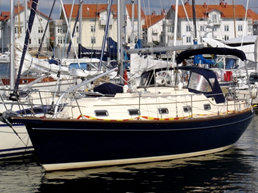
Alan & Christine Williams
John Beale
My boat is a 9 ton Hillyard called Bella Ropha, now designed for geriatric sailing on the
East Coast near Harwich and kept in Walton backwaters. I am hoping to keep afloat
during the winter months and visitors are always welcome. Previously, for about 7 years,
we kept her in Aigues. About myself, I served my time with the Bankline and then went on
to be second mate with them from 1953 to 1959. I then went on to General Steam
Navigation leaving them 1961 when I came ashore and worked initially for the Shippimg
Federation and then on to a London Shipping Agency when I became a member of the
Chartered Shipbrokers. Subsequently, like many others, I changed career directions when
the container revolution came in!
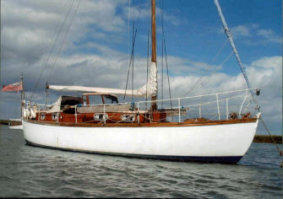
David Cornes
I served an apprenticeship with Ellerman’s Hall Line from 1953 until 1957 and
afterwards sailed with Ellerman’s officer pool on worldwide cargo routes until I joined
Ellerman’s Wilson Line, mainly on Scandinavian trades. I came ashore in 1963.
I learned to sail in 1980 and have varied training experience including Skipper of
chartered Rival 42 taking local kids on sailing trips to the Channel Islands and Brittany.
I was also Mate and occasional Master of “BICHE”, an ex-Breton Tunnyman operating
charters from Poole, Dartmouth, the Channel Islands and Brittany as well as local day
sailing.
Biche is now fully restored by “Les Amis du Biche” at Lorient.
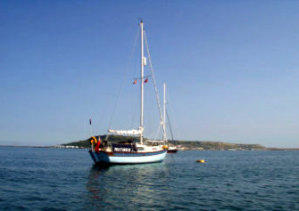
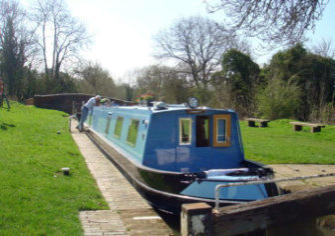
John Rose
Page 2 of 4
Richard Winterburn
We keep our boat “Little Kingfisher”
in Beccles at the Galleon Storage
and Mooring facility on the River
Waveney. This “mooring” is in fact a
boat yard with dry land storage for
probably in excess of 100 boats up
to around 25 or 30 feet. The real
advantage is that the boats are kept
out of the water on cradles and
racks and only launched as and
when required by the owners using
a large lift facility. The yard has
pontoon berths on the river for around a dozen boats but these are only used for temporary mooring for boarding, recovery etc.
For us, this yard provides full, all weather security without the need for concern of weather or tides etc, which is useful if one is not
using the boat for any length of time. There are also full power, water, pump out and maintenance services available and out of
season provides easy access for work on the boats.
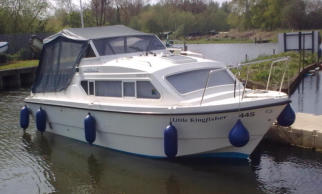


Page 2 of 4
Membersof the MNA Boat Club certainly have some interesting craft – a good example of what I mean is Arthur Woodhouse’s 41
foot converted Mark 3 LCS (Landing Craft Support) now called “Wanderer” which was built for the Royal Navy around 1942/43 - All
the details described below were provided by Arthur, but I assume that at least some of the kit has probably been removed by now –
if not it would probably be wise not to upset Arthur and to give Wanderer a wide berth! She’s around 12 tons, including side armour
over her wooden construction, carries (or carried) a quarter-inch smoke mortar, two ½” heavy machine guns and two .303 machine
guns - she carried a crew of eleven, with power provided by two 130bhp Ford petrol engines.
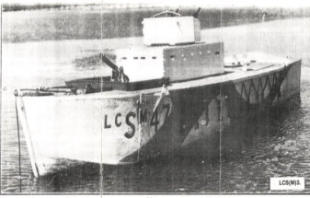
Wanderer in 1944
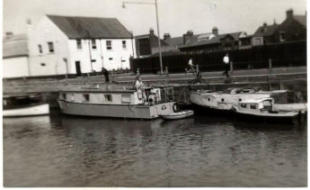
Wanderer at Great Yarmouth 1955
Arthur Woodhouse

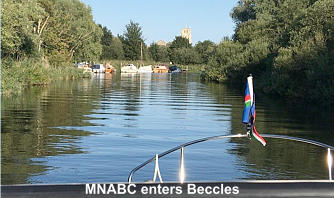
Experiences at 2022 AGM
Albion Adventure
By: David Cornes
I
was
very
happy
to
attend
the
MNA
Boat
Club
AGM
in
September
2022
at
the
little
Norfolk
Broads
village
of
Neatishead.
The
following
day
I
was
able
to
take
part
in
an
event
associated
with
the
AGM
–
a
day
out
on
the
Broads
on
the
‘Albion’.
The
‘Albion’
is
one
of
two
surviving
Norfolk
Wherries,
and
the
only
one
currently
sailing.
She
is
owned
and
operated
by
the
Norfolk
Wherry
Trust
who
purchased
her
in
1949
in
order
to
preserve
her
as
an
example
of
the
Norfolk
Wherry,
the
sailing
barges
who
served
the
Norfolk
Broads
and
were
specifically
adapted
to
the
conditions
prevailing
there.
‘Albion’
is
now
125
years
old;
some
65
feet
overall
and
able
to
carry
up
to
40
tons
of
cargo.
She
is
maintained
in
first
class
condition
by
the
Trust
and
is
operated
by
a
team
of
volunteers and is funded mainly by passenger charters, one of which I joined.
I
joined
her
at
the
Trust
base
at
Womack
near
Ludham
with
some
other
Boat
Club
members–
fortunately
my
Sat-Nav
was
able
to
find
the
location
-
and
after
a
safety
briefing
and
issue
of
lifejackets
the
‘Albion’
got
under
way.
We
left
our
jackets
etc.
in
the
hold
as
it
looked
as
though
we
were
in
for
a
warm
shirt
sleeves
rig
day,
the
hold
also
contains
a
toilet
and
a
cooker
and
plenty
of
seating.
‘Albion’
is
berthed
in
a
little
dock
on
the
River
Thurne.
She
has
no
engine
but
power
is
supplied
by
a
dinghy
with
an
outboard
lashed
to
one
quarter
with
a
fender
between.
The
outboard
is
usually
operated
by
the
Mate,
who
jumps
into
the
dinghy
to
change
the
throttle
setting
when
required.
Security
is
maintained
by
a
red
safety
line
attached
to
the
‘Kill
Cord’
and
fastened
on
Albion’s quarter. We set off down the River Thurne with this method and set the sail.
Perhaps
a
word
about
the
‘Albion’s
unique
rig
might
be
useful
at
this
point.
The
mast
is
unstayed,
apart
from
a
forestay,
there
is
no
other
‘Standing
Rigging’.
The
mast
is
therefore
a
very
substantial
spar.
It
is
stepped
in
an
equally
substantial
Tabernacle
at
the
fore
end
of
the
hatch
and
the
foot
is
furnished
with
a
very
substantial
counterweight,
which
rises
up
through
the
foredeck
via
a
hatchway
when
the
mast
is
lowered,
by
slackening
the
forestay
purchase.
The
single
sail
is
suspended
from
a
very
substantial
gaff,
which
extends
the
sail
such
that
the
leach
is
practically
vertical.
The
halyard
system
is
unique
to
the
Norfolk
Wherry.
All
other
vessels
with
gaff
sails
have
two
sets
of
halyards,
one
for
the
Throat
and
one
for
the
Peak.
The
wherry
has
one
halyard
which
leads
up
from
the
deck
through
a
double
block
at
the
mast
head,
through
a
single
block
at
the
throat
of
the
gaff,
back
to
the
masthead
block,
down
to
a
block
with
a
span
attached
to
a
couple
of
points
on
the
gaff,
and
leads
up
to
and
is
finally
made
fast
to
the
masthead
block.
The
sail
is
then
hoisted
by
the
halyard
led
to
a
geared
winch
at
the
fore
side
of
the
mast.
The
sail
was
actually
hoisted on this occasion by myself and another Boat Club member, and it was not a very heavy job.
We
sailed
down
the
Thurne
and
then
ascended
the
river
Bure.
The
conditions
were
a
mainly
cloudy
day
with
light
winds,
often
diminished
and
diverted
by
vegetation
on
the
banks
and
thus
were
able
to
experience
every
point
of
sailing
many
times,
and
in
rapid
succession!
‘Albion’
tacked
and
gybed
as
necessary
with
little
fuss,
assisted
by
the
dinghy
outboard
when
necessary,
the
throttle
operated
by
the
Mate
who
jumped
into
the
dinghy
from
his
normal
position
by
the
little
knee-high
‘cockpit’
at
the
after
end
of
the hatch from where he also tended the mainsheet, cleated on the after end of the coaming, where necessary.
We
arrived
at
Horning
which
was
our
lunch
stop,
and
where
some
of
the
passengers
departed
and
our
MNA
President,
Vivien
Foster
OBE,
joined
us
for
the
return
trip.
I
had
elected
to
stay
on
board
‘Albion’
for
the
whole
day
as
being
a
unique
experience,
not
to
be
missed.
I
was
offered
a
spell
at
the
helm
which
I
enthusiastically
accepted.
She
is
steered
by
a
very
large
rudder,
some
six
feet
in
length,
which
is
controlled
by
a
substantial
tiller
operated
from
the
little
knee-high
cockpit
which
also
leads
by
a
further
step
down
into
a
little
cuddy,
crew
accommodation
when
she
was
working.
The
only
helm
order
I
was
given
was
‘Keep
her
in
the
middle’,
which
I
endeavoured
to
do.
Not
surprisingly
she
takes
a
little
while
to
respond
to
her
helm,
and
a
bit
of
anticipation
as
to
when to take helm off is required, she certainly is not hard to steer in those conditions.
We
noticed
some
black
rain
clouds
creeping
across
the
Broads
to
one
side
of
us
but
thought
that
they
would
probably
pass
astern,
so
we
continued
to
sail
in
our
shirt-sleeve
rig.
Most
other
traffic
has
given
us
right-of-way
up
to
this
point,
indeed
the
Skipper
had
told
us
that
we
had
precedence
over
most
other
traffic
on
the
Broads,
however
at
this
moment
a
charter
sailing
yacht
crossed
our
bows
and
then
tacked
back,
putting
her
on
a
collision
course.
The
Skipper
ordered
the
helm
over
and
told
the
Mate
to
let
go
the
Mainsheet
to
depower
the
sail.
As
she
started
to
respond
we
were
suddenly
engulfed
in
a
heavy
rainstorm
with
a
heavy
gust
of
wind;
with
which,
with
the
helm
already
over
and
the
mainsail
running
out
to
right-angles,
‘Albion’
headed
for
the
reeds
along
the
bank,
where
she
remained
pressed
to
the
bank.
The
mainsheet
continued
to
run
out
and
unrove
and
the
sail,
with
no
Standing
Rigging
to
inhibit
it,
continued
around
to
the
fore
side
of
the
mast.
The
downpour
continued
and
all
hands,
including
Vivien
our
President sitting on the foredeck, were drenched to the skin by this time!
The
Skipper
suggested
that
I
step
into
the
Cuddy,
I
don’t
think
that
this
was
in
consideration
for
my
welfare,
as
we
were
all
soaked
to
the
skin
by
this
time!
As
well
as
himself
and
the
Mate
there
was
also
a
Trainee
Skipper
and
a
Trainee
Mate
on
board
and
I
am
sure
that
he
decided
that
he
needed
experienced
hands
at
a
time
like
that.
I
might
therefore
be
slightly
adrift
as
to
the
sequence
of
events
following.
The
squall
had
eased
and
the
first
task
was
to
re-reeve
the
mainsheet
and
get
the
sail
back
abaft
the
mast,
the
sail
was
then
lowered
onto
the
deck
and
the
task
of
getting
her
off
the
bank
was
commenced.
This
was
accomplished
by
the
use
of
the
dinghy
with
its
outboard
and
the
use
of
the
‘Quants’;
long
poles
with
a
fork
on
the
bottom
and
a
shoulder
button
on
the
top
used to pole the vessel in the way that a punt is propelled by punt poles.
Once
‘Albion’
was
under
way,
with
propulsion
provided
by
the
dinghy,
it
was
noticed
that
there
were
lightning
flashes
visible
close
by.
Standing
Orders
are;
that
in
the
event
of
lightning,
the
mast
is
to
be
lowered,
so
the
forestay
purchase
was
slackened
off
and
down came the mast to join the gaff and sail on top of the hatch.
It
was
then
time
to
get
below
and
remove
my
sodden
shirt.
A
kind
member
of
the
crew
kindly
loaned
me
a
dry
tee
shirt
to
wear
under
my
waterproof
jacket,
now
perhaps
a
bit
superfluous!
When
I
returned
it
when
we
docked
it
was
sopping
wet
below
the
waist
where it had been in contact with my wet trousers!
I
did
have
the
temerity
to
ask
the
Skipper,
trying
not
to
teach
granny
to
suck
eggs,
whether
it
would
not
be
useful
to
have
a
figure-
of-eight
knot
on
the
end
of
the
Mainsheet.
He
replied
that
they
had
given
some
consideration
to
this
very
point
and
had
decided
that;
in
the
event
of
having
to
let
go
the
mainsheet
for
any
reason,
it
was
better
for
the
sail,
unencumbered
by
any
Standing
Rigging, to go forward of the mast to de-power it. I have to admit that this made good sense.
Thus
we
returned
under
power
to
our
dock,
where
we
helped
to
turn
her
and
back
her
in
to
her
usual
berth.
So
ended
a
very
interesting and enjoyable day, enlivened by a bit of excitement!
I
was
most
interested
to
learn
more
about
this
unique
sailing
craft,
evolved
to
satisfy
the
local
conditions
on
the
Broads
which
I
had
only
read
about
before.
I
knew
something
about
the
evolution,
equipment
and
handling
of
the
other
classic
British
sailing
barge,
the
Thames
‘Spritty’,
of
which
there
are
many
surviving
still,
but
I
can
only
applaud
the
efforts
of
the
Norfolk
Wherry
Trust
in
maintaining
and
operating
this
almost
unique
example
–
there
is
another
partly
restored
privately
owned
wherry
in
the
Trust’s
dock,
but she is not rigged at present.
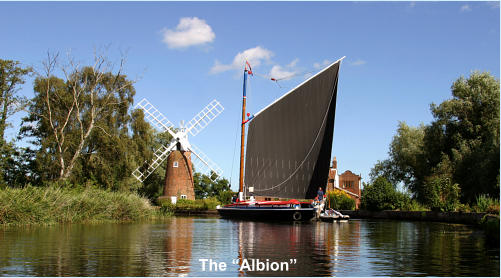
Merchant Navy Association Boat Club
(Affiliated to the Merchant Navy Association National Charity)
MEMBERS CONTRIBUTIONS
Please send YOUR contribution to us for inclusion here.
Anything which may be of interest to other members will be welcomed. For example: career details, anecdotes, current
boat details (with photo if available), comments and opinions on the contents of the website etc. Email Clive Edwards at:
clivecgedwards@gmail.com
Click to view:

